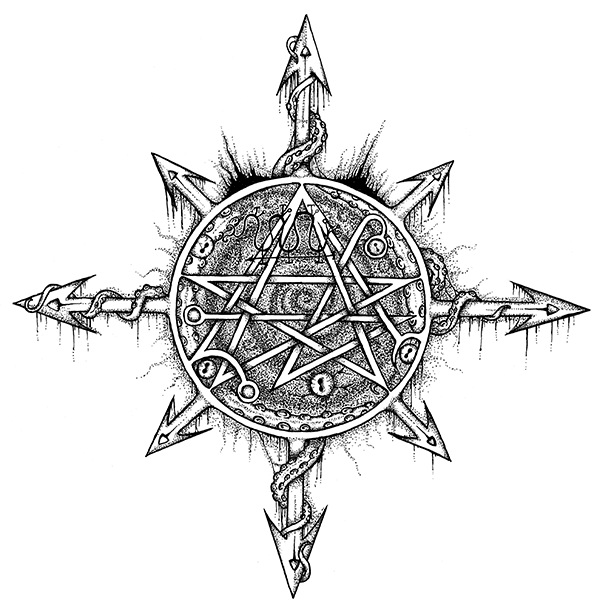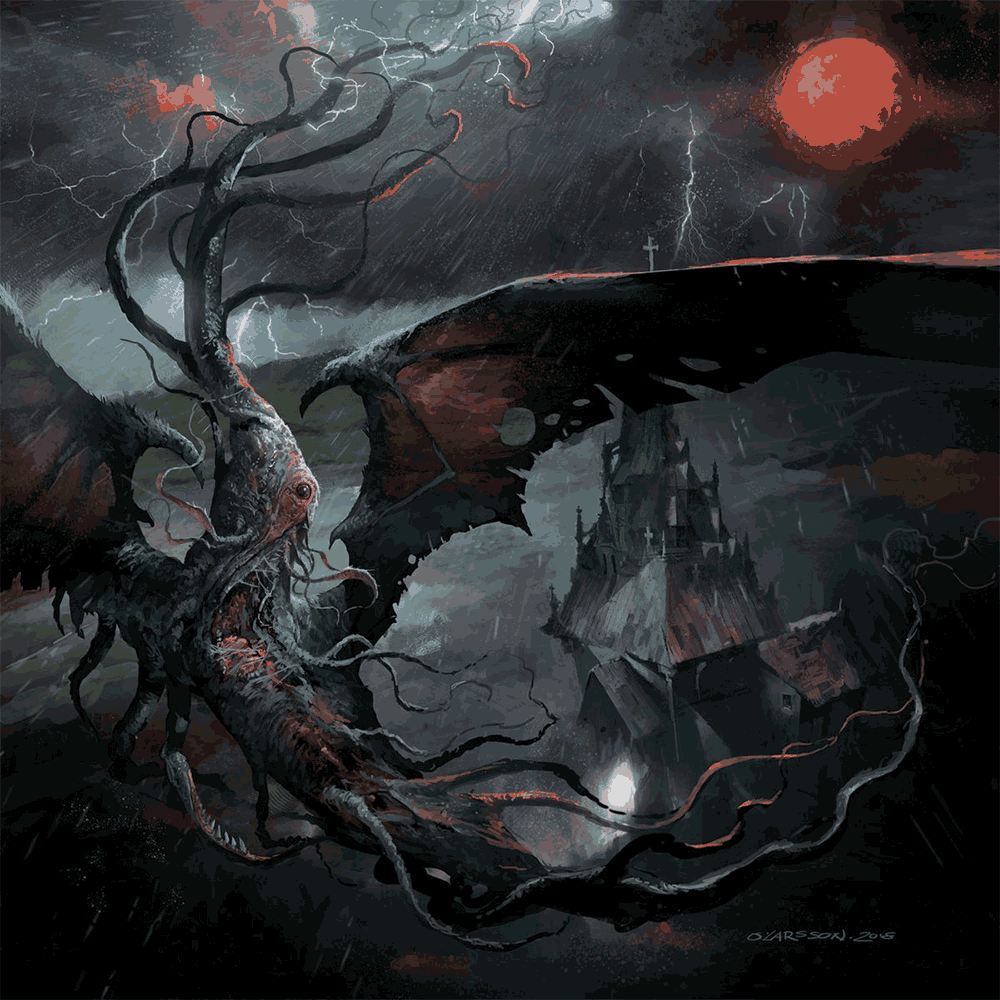Sulphur Aeon
2019-07-31
by Niklas Göransson
Death metal drawing from the deepest recesses of the primordial sea – Germany’s Sulphur Aeon lend their voices to the one who lies dreaming in subterranean temples.
– To me, says guitarist T, “The Scythe of Cosmic Chaos” represents the next step in our musical journey. While our records contain certain typical elements making them clearly recognisable as SULPHUR AEON, each one also has a real individual character. For instance, I’m still completely satisfied with and wouldn’t change a note on any of our output since the 2012 “Deep Deep Down They Sleep” seven-inch. I believe an album should be so much more than simply a collection of songs – it has to work in its entirety. “The Scythe…” is simply the best record I could’ve written right now and I’m fully satisfied with the end result. The production was by far the most time-consuming and demanding process we’ve ever been through, as well as one of the best musical experiences since I first started playing. Working with Michal Zech was really inspiring and we were incredibly fortunate in that he and our long-time producer, Simon Werner, instantly found the optimum mindset to create the perfect sound for this album.
The riffs and innovative song structures are much-lauded aspects of SULPHUR AEON but, as an enthusiast of intricate vocal arrangements, I was quite partial to M’s varied and occasionally theatrical oratory performance. It’s also evident from the maniacal chanting that its conveyor is passionate about the lyrical themes.
– Coming from a black metal background, says M, I’m entirely convinced that one needs the ability to both identify with and feel what one sings about. I’m not someone who likes to perform other people’s lyrical endeavours, simply because I know it’s not truly me. I’ve always been like that. So, back in the band’s beginnings, our first step after the 2010 demo – which had already been fully composed with lyrics written when I joined – was selecting a fitting concept, and Lovecraftian themes seemed like the natural choice.
From reading previous interviews, it’s rather obvious that M is somewhat of an authority on American horror author H.P. Lovecraft’s Cthulhu mythos. These concepts translate rather well to the music which, in turn, exhibits a certain warped quality leaving it especially suited to tentacled thematics. So, with this synergy between lyrics and composition in mind, I’m wondering if T is also a Cthulhian connoisseur.
– Of course, I’m a big Lovecraft fan and have read most of his writings. The reason M is responsible for answering interview-questions concerning our concept is that he authors all lyrics and is therefore better suited to explaining them. We have a special way of working together: whenever a new song has been finished, I leave it completely up to him to find the specific theme and suitable voices for creating this unique atmosphere.
– I’m not sure why our symbiosis of music and vocals match so well, says M. In our case it’s difficult to achieve because when confronting the studio microphone, I’m singing the songs for the very first time. Then it’s only me and my lyrics, I have mostly clear visions and know intuitively what kind of vibe I want to go for. I suppose when it comes to recording vocals in a studio, I must be an ’actor’. However, on stage it’s totally different; when invoking the names of the unspeakable ones, I mean it wholeheartedly. For forty-five to sixty minutes, I’m in a trance which lasts until the music ends – but once it’s over and the adrenaline kick ends, I mostly want to leave.
That would be what’s called a flow state, is the music composed in similar fashion?
– An absolute yes sir, says T, but it’s very hard for me to explain the way I compose. When beginning a new song, I don’t have any particular schemes or even loose plans. The most difficult part for me is finding the foundational riff or melody and it can be very frustrating sitting there, playing, and simply have nothing of worth come out. But should that specific riff appear, instant tunnel-vision sets in. Then, in a way, it’s like the song itself tells me where to go next and I feel as if completing it is the single most important matter on this planet; I even dream of whatever composition I’m working on. And I never write two songs at the same time – I guess the feeling that one or the other will end up lacking in something would drive me insane.

SULPHUR AEON do play live shows but rather sporadically. Both T and M have previously stated their disinterest in performing more often, which I thought was noteworthy since I’ve been led to believe that “The Scythe of Cosmic Chaos” is doing really well sales-wise – a claim Spotify and Last.fm statistics lends some credibility to. These days, touring and selling merch is really the only options left for black and death metal bands to generate any relevant revenue so it’s interesting to learn they have no intention of monetising the project.
– Of course, we get a lot of offers but it just has to feel right – and even with that in mind there have been some mistakes which we’ve then been forced to learn from. And as much as I enjoy the actual moment of being on stage, there are many aspects I really dislike about live shows: all the waiting around and then stressful changeovers being two examples. We’re currently in the lucky position where our label, Ván Records, totally supports our approach. Don’t get me wrong, we’re more than grateful for what we’ve achieved thus far but I prefer keeping things the way they work for us.
– Many extreme metal bands have tried monetising their act, continues M, and they’ve all either vanished or turned into lame shit. It feels very weird being blessed with a status like this but, hell, please kill me if I ever start wielding fucking plastic weaponry!
So you have neither ambition nor interest to tour, or anything like that?
– Touring on a regular basis is simply not possible for us, says T, we’re not in our twenties any longer – all of us have day-jobs and other commitments. However, there’s a small tour with CHAPEL OF DISEASE planned for this autumn – this is more of an experiment, just to see if performing nine nights in a row works and whether we even enjoy the experience. We’ve never done that before, we only played single shows. When the offer came it just felt right and, at the end of the day, I don’t ever want to say that ’We never even tried it.’ But this has nothing to do with us wanting to promote our record; it’s just something we’d like to have done together, as a band and as friends.
– Honestly, adds M, touring has always been – and still is – the biggest horror I could imagine. I’m not the most enthusiastic guy when it comes to playing live shows but, as T already stated, it has to be done. Or, we at least have to try and see if our synergies can endure and survive a tour.
– But reaping any kind of commercial success with SULPHUR AEON was never our intention, continues T, making money with the band would also mean far more compromises than I’m willing to allow for. When the band first started, we didn’t even want to play live at all but a lot of things, far more than we ever dreamed of, just happened. For example – when Swedish artist Ola Larsson agreed to create the artwork for our debut, “Swallowed by the Ocean’s Tide” (2013), one such dream came true. Ever since seeing his artwork for DISMA‘s “Towards the Megalith” and their split EP with WINTERWOLF, we knew he’d be perfect for SULPHUR AEON.

These paintings used on each of their three album covers truly are something – more so than metal aesthetics, they look like the artwork one used to find in old tabletop role-playing games.
– Funny that you would mention role-playing games, says M, Ola has created quite a lot of artworks for Swedish RPGs like Mutant, Chock and Götterdämmerung. However, these days he mainly works as a background artist for Swedish animated movies for kids. He’s been around since the early 90s, creating art for bands like TRAUMATIC, NECRONY, THY PRIMORDIAL, MITHOTYN, INDUNGEON, and CRANIUM. Nowadays, we’re pretty much the only band he’s worked with over an extended period of time. T first suggested it to Philipp of Imperium Productions back in 2011 or 2012 so he simply contacted him. To our surprise, Ola was very interested in creating more Lovecraftian artworks so we came together and had lengthy chats about what I had in mind and he came up with this beautifully haunting and perfectly detailed rendition of R’lyeh and its most prominent dreaming ruler. He really nailed it there. We stayed in touch ever since and he became our, well… kind of court artist. “Gateway to the Antisphere” (2015) was more complex and the process of creating it far longer, but a lot of fun and very satisfying for me. Ola has made two interesting ‘making of’ from our first two covers available on his official Facebook page, check them out!
Do you usually bring an album’s artwork into your listening experience?
– Not that much nowadays, says T, but of course I still love great artwork that really captures and breathes the atmosphere of an album. It was different when I discovered my personal classics, with all their iconic artworks; I’d listen to the whole album with the cover in my hands. Still, to this day, I have those images in my mind once the first track or intro of one of those records comes on. But when it comes to other bands, especially recent ones, I’m really far more of a listener than visual guy. This might seem a bit weird, because for our own art the whole visual aspect and concept is of huge importance for me.
– I don’t think it’s weird, says M, but I gotta admit that I rarely do it either; mainly because of two reasons. Firstly, I simply don’t have as much time these days and – for the most part – it’s not very common that I come across newer albums which catch my attention visually. But when it does happen, the very first listen of the physical medium will always include a full booklet inspection along with the noise. And I fully agree with what my comrade said, about how different it was with albums I grew up on. Yet it still happens from time to time, be it a new album or an overlooked classic that I discover…



